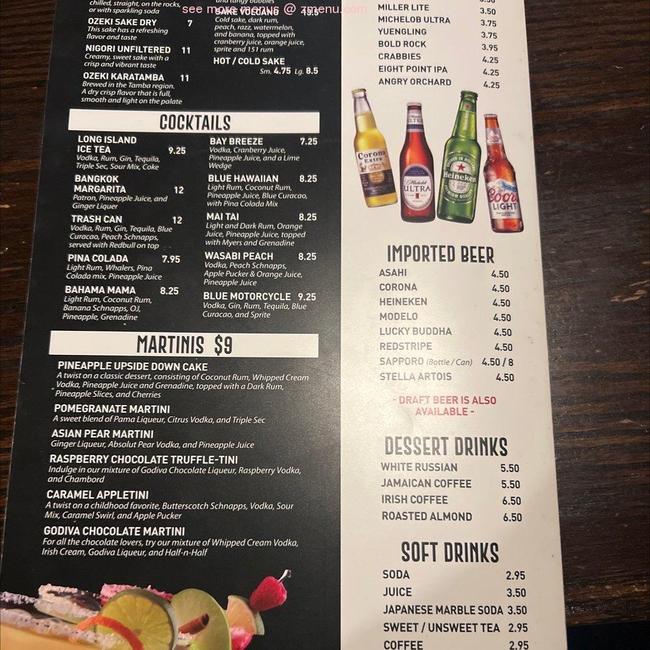Wasabi Lynchburg is not just a culinary delight; it represents a unique blend of cultures, flavors, and traditions that have shaped the food landscape of Lynchburg, Virginia. This article will delve into the fascinating world of wasabi, exploring its origins, uses, and the growing popularity of wasabi-infused dishes in Lynchburg. We will also examine the local restaurants that have adopted this vibrant ingredient into their menus, offering diners an unforgettable experience.
As food enthusiasts are becoming more adventurous, wasabi has moved beyond its traditional role as a condiment for sushi. It has started to make its mark in various culinary creations, and Lynchburg is no exception. The rise of wasabi in this city speaks to a broader trend of fusion cuisine, where chefs experiment with ingredients to create innovative dishes that tantalize the taste buds.
In this comprehensive guide, we will explore the many facets of wasabi Lynchburg, from its history and cultivation to its culinary applications and local popularity. Whether you're a seasoned foodie or just curious about this spicy green paste, there's something here for everyone to enjoy.
Table of Contents
The History of Wasabi
Wasabi, also known as Japanese horseradish, is a plant native to Japan. Its scientific name is Wasabia japonica, and it has been used in Japanese cuisine for centuries. The use of wasabi can be traced back to the 16th century, where it was served with sushi to enhance the flavor and add a spicy kick. Unlike the common horseradish found in Western cuisine, true wasabi is known for its unique flavor profile, which is more aromatic and less pungent.
Traditional Uses in Japanese Cuisine
In Japan, wasabi has been an integral part of meals, often paired with sashimi, sushi, and even soba noodles. It is grated fresh and served as a condiment, enhancing the umami flavors of the dishes. Authentic wasabi is prized for its subtle heat and complex flavors, making it a staple in traditional Japanese cooking.
Cultivation of Wasabi
The cultivation of wasabi is a meticulous process that requires specific environmental conditions. Wasabi thrives in cool, shaded, and moist areas, often found in river valleys and mountain streams. The plant is typically grown in waterlogged soil, which helps maintain the humidity it needs to flourish.
Challenges in Cultivation
Growing wasabi is not without its challenges. It is sensitive to temperature fluctuations and can take up to three years to mature. This slow growth cycle, combined with its specific cultivation requirements, makes authentic wasabi one of the most expensive condiments in the world.
Culinary Uses of Wasabi
Wasabi's culinary applications extend far beyond sushi. Chefs in Lynchburg and around the world have begun to incorporate this ingredient into a variety of dishes, showcasing its versatility.
Innovative Dishes Featuring Wasabi
- Wasabi-infused salad dressings
- Wasabi mashed potatoes
- Wasabi butter for seafood
- Wasabi-spiced grilled meats
Local Restaurants Embracing Wasabi
Lynchburg is home to several restaurants that have embraced the wasabi trend, offering unique and delicious dishes that highlight this ingredient. Here are some noteworthy establishments:
- Wasabi Grill - A fusion restaurant that offers a variety of sushi rolls, salads, and entrees featuring wasabi.
- Asian Bistro - Known for its creative use of wasabi in both traditional and modern Asian dishes.
- Spice Route - This restaurant incorporates wasabi into its Indian-inspired menu, creating a unique flavor experience.
Health Benefits of Wasabi
In addition to its culinary uses, wasabi is also known for its health benefits. It is rich in antioxidants and has anti-inflammatory properties. Some potential health benefits include:
- Boosting the immune system
- Improving digestion
- Providing antimicrobial properties
- Supporting cardiovascular health
Delicious Wasabi Recipes
If you're inspired to incorporate wasabi into your cooking, here are a few simple recipes to try at home:
Wasabi Mashed Potatoes
- Ingredients: Potatoes, butter, milk, wasabi paste, salt, and pepper.
- Instructions: Boil and mash potatoes, then mix in butter, milk, and wasabi to taste. Season with salt and pepper.
Wasabi Salad Dressing
- Ingredients: Olive oil, vinegar, wasabi paste, honey, salt, and pepper.
- Instructions: Whisk together all ingredients until smooth. Drizzle over your favorite salad.
Wasabi vs Horseradish: What’s the Difference?
While wasabi and horseradish may look similar and serve similar purposes in cuisine, they are distinct plants with different flavor profiles. Wasabi offers a more complex flavor with a subtle sweetness, while horseradish tends to be stronger and more pungent. Understanding these differences can enhance your culinary experience.
Conclusion
In conclusion, wasabi Lynchburg represents a vibrant culinary trend that celebrates the rich flavors and traditions of this unique ingredient. From its historical roots in Japanese cuisine to its growing popularity in local restaurants, wasabi is making a significant impact on the food scene in Lynchburg. We encourage you to explore wasabi-infused dishes and perhaps even try your hand at cooking with this exciting ingredient. Feel free to leave a comment below sharing your wasabi experiences or favorite recipes!
Call to Action
If you enjoyed this article, consider sharing it with friends or checking out more articles on our blog. Your feedback is important to us, and we would love to hear your thoughts!
Thank you for joining us on this culinary journey. We look forward to seeing you again soon!
Article Recommendations



ncG1vNJzZmilqZu8rbXAZ5qopV%2BcrrOwxKdvaK%2BRqK6jtYylsKebmJfCs7ONoaumpA%3D%3D